Wall Street Journal: Are stablecoins an innovation, or a modern rehash of 19th-century financial “plumbing”?
Original article from WSJ
Compiled by Odaily Planet Daily Golem ( @web3_golem )

Stablecoins: The modern-day “narrow bank”
Washington is renewing its promise to reinvent money in code, and the political headwinds behind the newly passed Genius Act in the United States have given new life to the recurring fantasy that technology can ultimately eliminate the instability at the heart of finance. While the promise is alluring, the reality is harsh: we can modernize money, but we're still moving it through pipes built in the 19th century.
This rosy notion stems in part from the collapse of Silicon Valley Bank in 2023. This wasn't a new problem caused by subprime mortgages or any exotic derivatives, but a replay of one of the oldest pitfalls in banking: maturity mismatch. Depositors, especially those without insurance, could withdraw their deposits on demand, but banks were required to invest for the long term. When interest rates soared and trust eroded, user withdrawals followed, assets were sold at fire sale prices, and the government was forced to intervene again.
"Narrow banking," where institutions hold only cash or short-term government bonds, was once considered a solution. (Note: The concept of "narrow banking" originated in the United States after the Great Depression in the 1930s. It refers to a banking model that only accepts deposits and invests all or almost all of these deposits in highly liquid, ultra-low-risk assets (such as short-term government bonds or central bank reserves).)
Although "narrow banks" have a high safety factor, they lack vitality and are unable to create credit. There are no loans and no growth.
Stablecoins are the tech-era reinvention of “narrow banking”: private digital tokens pegged to the US dollar and claimed to be backed by a one-to-one liquidity reserve. Tether and USDC, for example, claim to offer programmable, borderless, tamper-proof deposits without the regulatory burden.
But strip away the digital veneer and the age-old fragility of finance remains: these tokens still rely entirely on trust. Reserves are often opaque, custodians may be offshore, audits are optional, and redemption remains just a promise.
Therefore, when trust is shaken, the entire system collapses. The TerraUSD stablecoin collapsed in 2022 because it attempted to maintain its peg to the US dollar using algorithms rather than real reserves. Its value depended on another redeemable token, Luna. However, when confidence collapsed, investors rushed to redeem TerraUSD, dumping large amounts of Luna into the market. Without reliable collateral and with the situation escalating, both tokens collapsed within days. Beyond this extreme case, even so-called "fully collateralized" stablecoins today experience price fluctuations when the market questions the authenticity of their reserves.
The Genius Act fuels the dollar’s “exorbitant privilege”
The Genius Act represents Washington's attempt to establish a stablecoin order. It creates a formal category of "payment stablecoins," prohibits stablecoin issuers from paying interest to emphasize their utility value over speculation, and requires issuers to be fully collateralized with cash or Treasury bonds. Issuers must obtain a license, register in the US, and undergo a new certification system. Foreign participants must obtain a US license and comply with US rules, or they will be eliminated.
The bill's advantages are clear: no fancy algorithms, no unregulated randomness, and no mixing of speculative and payment functions. It fulfills many of their aspirations. It provides consumer protections, prioritizes redemptions in bankruptcy, and promises monthly reserve disclosures. Academics who criticized crypto chaos finally got their wish.
But clarity doesn't guarantee safety. The bill formally defines stablecoins as "narrow banking." This means stablecoins won't experience maturity mismatches, but it also eliminates trusted intermediaries, bypassing the core engine of the financial industry (converting savings into investment), leaving risk-averse funds idle.
At the same time, the bill leaves strategic loopholes. Issuers with less than $10 billion in assets can opt for state-level oversight, which encourages regulatory arbitrage. In a crisis, demand for stablecoin redemptions could trigger a sell-off in Treasury bonds, disrupting the safe-haven market that supports them.
Some economists warn that by anchoring stablecoins to Treasury bonds, we are simply shifting systemic risk to a new corner, one that, while politically popular, remains operationally untested at scale. But supporters also tout the geopolitical benefits. The law ensures that stablecoins are pegged to the US dollar, backed by US dollar reserves (such as Treasury bonds), and settled through US institutions. As non-US dollar stablecoins remain stagnant, US-backed digital tokens will become the default tool for global payments, savings, and cross-border transfers.
It’s Bretton Woods meets Silicon Valley, a regulatory tussle aimed at extending the dollar’s exorbitant privilege into the internet age. The Genius Act may do more to entrench the dollar’s dominance than any Fed swap line or trade agreement.
Another noteworthy benefit is that, by providing regulatory clarity, the bill could help bring cryptocurrency innovation back to the United States. In recent years, uncertainty surrounding U.S. law has led to an exodus of blockchain talent and capital. Despite their shortcomings, stablecoins could serve as a foothold for broader digital finance experiments to take place within U.S. institutions, rather than outside them.
Stablecoins haven’t taken over banking
But trust cannot be outsourced to code. It is created by institutions, audits, and rules. Ironically, blockchain, a technology born out of rebellion against financial regulation, is now seeking legitimacy through the very disclosures and oversight it once sought to evade. The Genius Act provides this clarity, but the trade-offs are already becoming clear.
In finance, as the proverb goes, great power often masks greater fragility. If stablecoins become integrated into everyday transactions, their failure would have repercussions not limited to the crypto world but would become a shared problem for households, businesses, and taxpayers.
The bill also opens the door for large technology companies or business giants to enter the payments sector under relatively loose rules, raising concerns about privacy, competition and market concentration in a digital dollar infrastructure dominated by scale rather than security.
Despite the ongoing hype, stablecoins haven't overtaken banking. They've simply replicated banking's contradictions in a new form. The true promise of blockchain was to end trust. Yet, we now have a doubling-down on trust under federal regulation.
Money remains a social contract: a promise that someone, somewhere, will cover your losses. No amount of code or collateral can eliminate the need for this promise to be trustworthy. At the same time, no amount of regulation can abolish the fundamental trade-off in finance: security comes at the expense of efficiency. Forgetting this is inviting the next crisis.
Stablecoins repackage old risks as innovation. The danger lies not in what they are, but in pretending they are something they are not.
- 核心观点:稳定币是数字时代的“窄银行”,但未解决金融核心风险。
- 关键要素:
- 稳定币依赖信任,储备不透明,存在赎回风险。
- 《Genius法案》将稳定币锚定国债,转移系统性风险。
- 法案可能巩固美元霸权,但引发监管套利担忧。
- 市场影响:稳定币监管或加剧金融脆弱性与美元主导。
- 时效性标注:中期影响。



